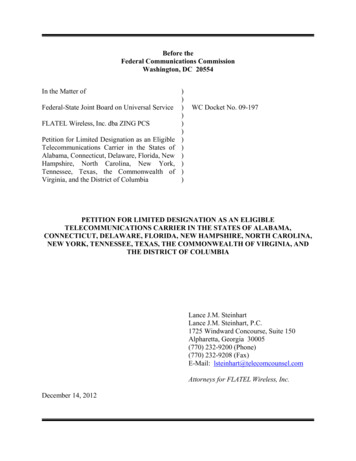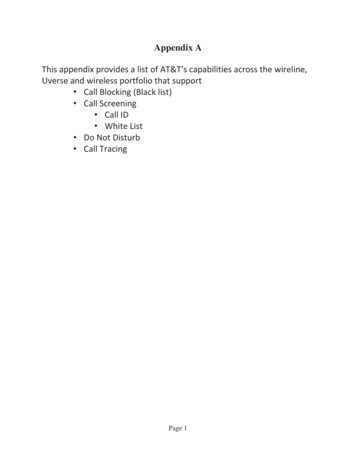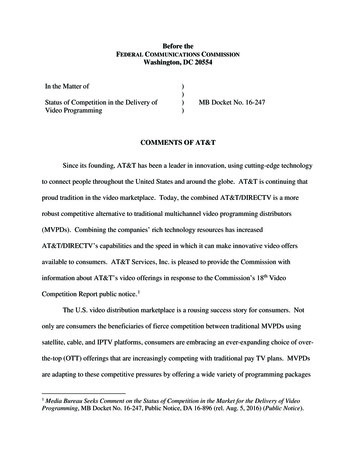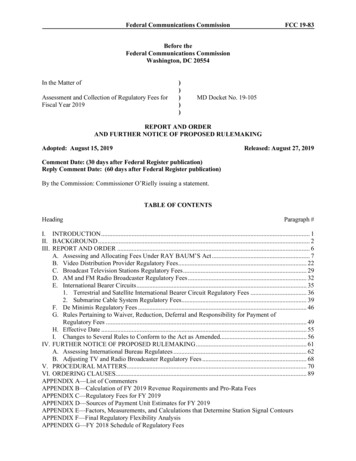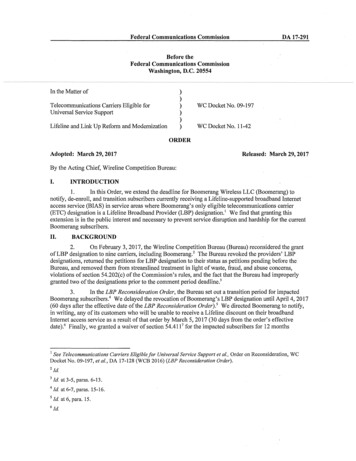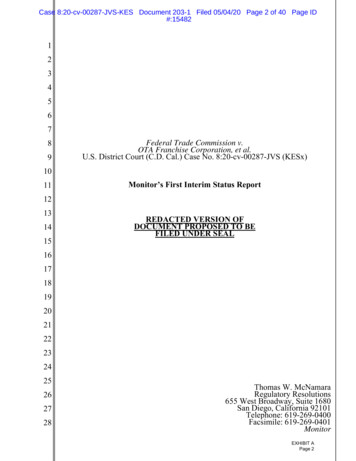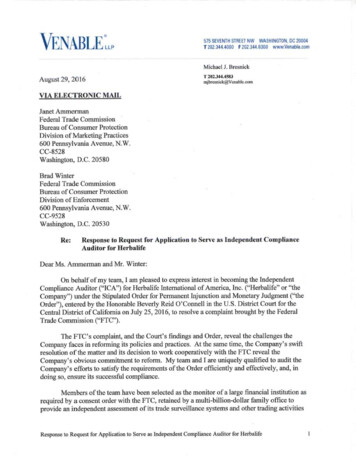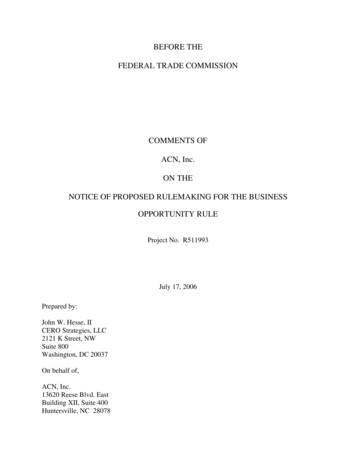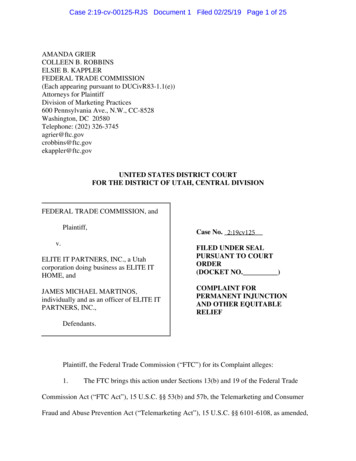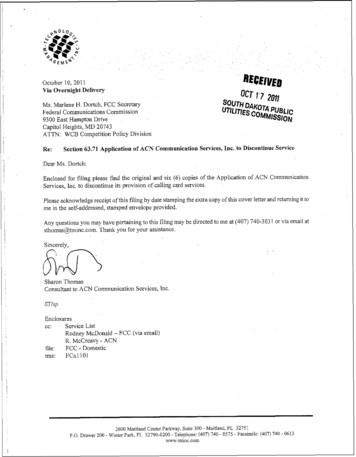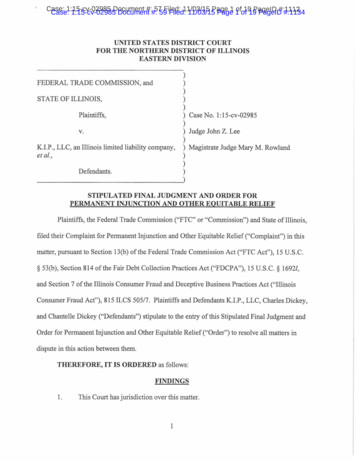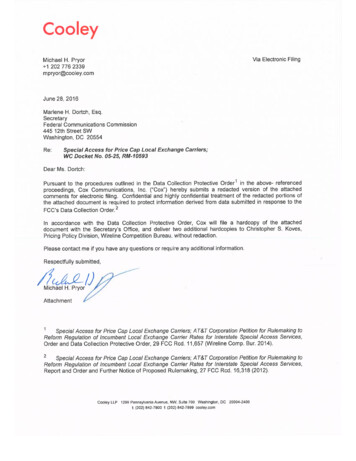
Transcription
CooleyVia Electronic FilingMichael H. Pryor 1 202 776 2339m pryor@cooley.comJ une 28, 2016Marlene H. Dortch, Esq.SecretaryFederal Communications Commission445 12th Street SWWashington, DC 20554Re:Special Access for Price Cap Local Exchange Carriers;WC Dockef No. 05-25, RM-10593Dear Ms. Dortch:Pursuant to the procedures outlined in the Data Collection Protective Order in the above- referencedproceedings, Cox Communications, Inc. ("Cox") hereby submits a redacted version of the attachedcomments for electronic filing. Confidential and highly confidential treatment of the redacted portions ofthe attached document is required to protect information derived from data submitted in response to theFCC's Data Collection Order.2In accordance with the Data Collection Protective Order, Cox will file a hardcopy of the attacheddocument with the Secretary's Office, and deliver two additional hardcopies to Christopher S. Koves,Pricing Policy Division, Wireline Competition Bureau, without redaction.Please contact me if you have any questions or require any additional information.Respectfully submitted,Michael H. PryorAttachmentSpecial Access for Price Cap Local Exchange Carriers; AT&T Corporation Petition for Rulemaking to Reform Regulation of Incumbent Local Exchange Carrier Rates for Interstate Special Access Services,Order and Data Collection Protective Order, 29 FCC Rcd. 11,657 (Wireline Comp. Bur. 2014).Special Access for Price Cap Local Exchange Carriers; AT&T Corporation Petition for Rulemaking toZReform Regulation of Incumbent Local Exchange Carrier Rates for Interstate Special Access Services,Report and Order and Further Notice of Proposed Rulemaking, 27 FCC Rcd. 16,318 (2012).Cooley LLP 1299 Pennsylvania Avenue, NW, Suite 700 Washington, DC 20004-2400t: (202) 842-7800 f: (202) 842-7899 cooley.com
REDACTED - FOR PUBLIC INSPECTIONBefore theFEDERAL COMMUNICATIONS COMMISSIONWashington, DC 20554In the Matter ofBusiness Data Services in an InternetProtocol EnvironmentSpecial Access for Price CapLocal Exchange Carriers)))))))WC Docket No. 16-143WC Docket No. 05-25COMMENTS OF COX COMMUNICATIONS, INC.Barry OhlsonJennifer PrimeCox Enterprises, Inc.975 F Street, NW, Suite 300Washington, DC 20004Jennifer HightowerJoiava PhilpottCox Communications, Inc.6205-B Peachtree Dunwoody Rd.Atlanta, Georgia 30328June 28, 2016Michael PryorJ.G. HarringtonHenry H. WendelCooley LLP1299 Pennsylvania Avenue, NW, Suite 700Washington, DC 20004-2400Counsel to Cox Communications, Inc.
REDACTED - FOR PUBLIC INSPECTIONEXECUTIVE SUMMARYThe Commission should not adopt rules in this proceeding that impose new regulatoryburdens on Cox and other competitive providers. Rate regulation of competitive providers, likeCox, will impose unnecessary burdens, because Cox has no ability to impose unjust orunreasonable rates so the proposed rules are unjustified and likely harmful to Cox’s competitiveofferings. In fact, the proposed regulations significantly impact investment decisions inadvanced facilities that are providing the alternative services the Commission says it wants toencourage.Cox comes to this proceeding with significant experience as a competitive provider ofinnovative communications services, having been among the pioneers in video, competitivetelephone, broadband Internet, and competitive commercial telecommunications services. Coxhas succeeded in the business services market by offering innovative services, as well as lowerprices and higher quality than its competitors. This competitive experience is important inevaluating the potential effects of the proposed rules.The proposal to regulate cable companies appears to be founded on a fundamentalmisunderstanding of cable networks. Cox’s fiber-based BDS and its limited Ethernet overhybrid fiber-coax (“HFC”) service run over separate networks and have substantially differentcapabilities. Cox has little ability to leverage its HFC plant when deploying fiber to newlocations; therefore, Cox faces the same barriers (and opportunities to serve) as CLECs indeploying fiber, including obtaining access to buildings and trenching costs. Cox’s fiber-basedBDS, which is far from ubiquitous, provides robust performance commitments and very highspeeds. Cox’s Ethernet over HFC, on the other hand, is provided over the same shared facilitiesused to provide Cox’s mass market voice, video and Internet services, sharply limiting offered-i-
REDACTED - FOR PUBLIC INSPECTIONspeeds and precluding guarantees of performance. Properly understood, Cox’s EoHFC does notfall within the Commission’s definition of BDS.More fundamentally, Cox disagrees with the Commission’s assessment that the BDSmarket is broken. Cox’s experience is that the marketplace is highly competitive, with numerousproviders willing and able to provide BDS in virtually every market. As a result, Ethernet pricesare already declining, which puts pressure on Cox’s ability to recover costs of construction.Regulated price reductions would further dampen new facilities deployment. Like any othercompany, Cox has minimum return requirements for any investment, and manipulating themarket with a mandate to lower prices would cause many fiber deployment projects that meetthose requirements today to drop below the necessary return. Cox would be faced with thedecision of whether to deploy its capital in areas with a more sound financial basis. A mandatedprice reduction could have a particularly large impact on Cox’s participation in the Schools andLibraries and Rural Health Care programs, where today Cox is an important and competitiveservice provider.The proposed rules would impose substantial administrative and operational burdens onCox without any meaningful regulatory or customer benefits. The Further Notice proposesongoing data collections that will replicate and extend the 2013 data collection, which was veryexpensive and used significant resources that could have been devoted to other purposes. Yet theFurther Notice does not consider the impacts on Cox and other competitors. Furthermore, theproposal to “benchmark” competitor rates against ILEC price caps would impose enormouscompliance burdens for competitive providers, like Cox, that do not price their products likeILECs or that offer services that do not correspond to ILEC services or service areas. The- ii -
REDACTED - FOR PUBLIC INSPECTIONongoing costs of these regulations would far exceed any possible benefit to competition or themarketplace and cannot be justified.- iii -
REDACTED - FOR PUBLIC INSPECTIONTable of ContentsPageINTRODUCTION . 1I.II.Cox Has Competed Aggressively for Business Customers. . 5A.Cox Has a History of Pioneering and Investing in Innovative Services . 6B.Cox Has Benefitted Business Customers by Offering Lower Prices,Innovative Services, and Higher Quality Products. . 8Cox’s Fiber Based BDS and Ethernet Over HFC Services Are CompletelyDifferent . 9A.Cox’s Fiber Network is Separate from Its HFC Network and Cox Facesthe Same Barriers to Fiber Deployment as Any Other CLEC. . 10B.Ethernet over HFC Is Provided over a Shared Network and Does NotProvide True BDS Services. . 14III.Cox Has No Ability to Impose Unjust or Unreasonable BDS Prices. . 19IV.The Proposed Regulations Could Impact BDS Investment Decisions . 21V.A.Forced Price Reductions Could Preclude Cox From Meeting Its RequiredRate of Return for Fiber Deployment. . 21B.The Commission’s Proposals Could Reduce Cox’s Provision of BDS toSchools, Libraries and Rural Health Care Facilities Participating in the ERate Program. . 22C.The Marketplace Already Produces Competitive Pricing . 24The Proposed Rules Would Impose Substantial Costs on Cox and Harm theCurrently Competitive Market. . 26A.The Further Notice Does Not Adequately Consider the Impacts ofOngoing Data Collection Requirements. . 26B.The Proposal to Benchmark Competitors’ Rates to ILEC Offerings and toRequire Conforming Rates to Be Posted Publically Would CreateSubstantial Administrative Burdens That Would Harm the BDS Market . 27CONCLUSION. . 29-i-
REDACTED - FOR PUBLIC INSPECTIONBefore theFEDERAL COMMUNICATIONS COMMISSIONWashington, DC 20554In the Matter of)))))))Business Data Services in an InternetProtocol EnvironmentSpecial Access for Price CapLocal Exchange CarriersWC Docket No. 16-143WC Docket No. 05-25COMMENTS OF COX COMMUNICATIONS, INC.Cox Communications, Inc. (“Cox”), by its attorneys, hereby submits its comments on theCommission’s Further Notice in the above-captioned proceeding. 1INTRODUCTIONCox was an early provider of competitive voice, high speed data, and business services,and has invested significantly in fiber and other infrastructure to provide a range of high-capacityservices designed to meet the needs of a diverse set of business customers. This experienceinforms Cox’s perspective on the regulatory regime proposed in the Further Notice.Cox appreciates that the Commission has long struggled with the appropriate level ofderegulation of incumbent local exchange carrier special access services, or as they are nowcalled by the Commission, BDS. For more than 20 years, Cox has competed fiercely withincumbents in all of its geographic markets, including having to arbitrate and litigateinterconnection agreements to facilitate entry into local markets to provide telecommunicationsservices to mass market and business customers.1Business Data Services in an Internet Protocol Environment, WC Docket No. 16-143, TariffInvestigation Order and Further Notice of Proposed Rulemaking, FCC 16-54 (rel. May 2, 2016)(“Further Notice”).-1-
REDACTED - FOR PUBLIC INSPECTIONCox, however, does not share the Commission’s view that the BDS market is “broken.”In its experience, the BDS market is highly competitive, with numerous providers offeringservices. If anything, competition is already driving Ethernet prices down so precipitously thatCox is finding it harder to justify the costs of new fiber deployment. As another indication ofcompetition in this market, Cox has found numerous alternatives to ILEC provided serviceswhere Cox needs to supplement its own facilities-based BDS with another providers’ wholesaleoffering. In fact, the majority, of Cox’s Ethernet Type II services are obtained from providersother than incumbent LECs. 2Nevertheless, Cox does rely on incumbent LEC wholesale BDS services and, like manyother CLECs, purchases BDS services from the ILECs under tariffs, some of which containcompetition-dampening provisions such as shortfall penalties. Cox therefore, appreciates theCommission’s efforts in addressing such provisions in the Tariff Investigation Order. Coxbelieves that the elimination of such provisions will enhance its ability to compete moreefficiently and looks forward to providing more wholesale services to other carriers as theirability to seek alternatives to incumbent LEC services increases due to the Commission’sactions. Cox believes that the Tariff Investigation Order goes a long way toward resolvingwhatever market failures may have existed in the BDS market as a result of any residualincumbent LEC market power. Cox’s contracts do not contain the types of provisions theCommission found unreasonable in the Tariff Investigation Order, which further shows thedisparate approach of the incumbent LECs it competes against. 32Declaration of Jeremy Bye and Larry Steelman, attached hereto as Exhibit 1 (“Bye Decl.”), at¶ 7.3The Commission declared unlawful incumbent LEC tariff pricing plans to the extent theycontain “all-or-nothing” provisions, which require customers “to commit all of their relevant inservice purchases, such as DS1 or DS3 channel terminations, to a single pricing plan.” It also-2-
REDACTED - FOR PUBLIC INSPECTIONGiven the Commission’s long-running efforts to promote competition, Cox was surprisedto read the proposals in the Further Notice asking whether companies like Cox, after making theinvestment to compete and achieve hard-fought results, should be subject to the samehistorically-driven regulation that applies to incumbent LEC provision of BDS, tempered only bya redefined notion of what constitutes a competitive market. It is puzzling that the Commissioncould view Cox as having the ability to control prices in this market to such an extent that itsrates would have to be regulated. In light of the great pains the Commission has taken to “do noharm” to growing competition in various communications segments, 4 it is hard to understandwhy it would skew so far toward regulation of facilities-based competitors such as Cox in thismarket.It appears that the Commission’s proposal to regulate cable companies is based on a coremistaken belief that they may have ubiquitous networks that can be used for high capacity,dedicated services. The Commission seems to believe cable companies’ HFC networkssomehow confer the ability on cable companies to offer BDS service, as the Commission definesit, “everywhere they have deployed DOCSIS 3.0.” 5 In particular, the Commission has suggestedthat cable company HFC networks could be vital to the deployment of 5G wireless technologyand it should, therefore, ensure access to that network at “reasonable” prices.found unlawful shortfall penalty provisions that allowed the seller to recover from the buyer anamount greater than the amount the buyer would have paid had it met its minimum commitmentlevel. Finally, the Commission declared that early termination fees were unreasonable if theyrequired the buyer to pay more than if it had fulfilled the term commitment. Further Notice at ¶¶95, 115, 149.4See, e.g., Direct Broadcast Satellites, Report and Order, 90 FCC 2d 676, ¶¶ 78-101 (1982)(adopting a “flexible regulatory approach” for direct broadcast satellite providers and decliningto adopt ownership restrictions or access requirements); Promoting Innovation and Competitionin the Provision of Multichannel Video Programming Distribution Services, Notice of ProposedRulemaking, 29 FCC Rcd 15995 (2014).5See, e.g., Further Notice at ¶ 221 (“Looking forward, it may already be or soon will be the casethat cable companies are able to supply BDS everywhere they have deployed DOCSIS 3.0.”).-3-
REDACTED - FOR PUBLIC INSPECTIONIt is fortunate that the Commission seeks input on these conclusions because they aresimply not borne out by the facts, at least as they apply to Cox’s services. As shown below,Cox’s fiber-based BDS services are far from ubiquitous. Cox has extended fiber to only afraction of the commercial locations in its markets. With regard to Cox’s Ethernet over HFC(“EoHFC”) service, Cox does not offer service guarantees for this service and thus it would notqualify as BDS under the Commission’s proposed definition. In any event, Cox’s EoHFC is notviewed by Cox’s customers as a viable alternative to fiber (or legacy TDM services) for manybusiness applications or for cell site backhaul. The Further Notice itself recounts variousinstances where CLECs or wireless carriers, such as Sprint, explain that EoHFC is a “poorsubstitute” for fiber-based BDS services and is not a viable BDS product. 6 Yet, the Commissionseems intent on regulating EoHFC services, in addition to cable’s fiber-based BDS, findingincongruently from the record that “[p]acket-based BDS, including over HFC, is a goodsubstitute for TDM BDS” 7 and proposing to include Ethernet over HFC in the BDS productmarket. 8Apart from the Commission’s erroneous assumptions regarding cables’ networks, theproposed regulations would impose substantial burdens that could harm the currently6See, e.g., Further Notice at ¶ 202 (“Sprint, for example, describes Ethernet over HFC as a poorsubstitute for fiber-based services.”); id. at n. 495 (stating that “‘while the cable companies’Ethernet-over-fiber and DSn-over-fiber services are competitive with Level 3’s dedicatedservices, the cable companies’ best efforts broadband Internet access and their Ethernet-overHFC services generally are not competitive with Level 3’s dedicated services’ [because] ‘most ofLevel 3’s customers do not view these services as sufficient to meet their needs’”) (quotingComments of Birch Communications, BT Americas Inc., EarthLink, Inc., and Level 3Communications, LLC, WC Docket No. 05-25, RM-10593 (filed Jan. 27, 2016) at 16, 18)(“Joint CLEC Comments”).7Further Notice at ¶ 160.8Further Notice at ¶ 189 (stating that EoHFC “have characteristics of BDS carried over fiber: itcan be used to provide access to the Internet and point-to-point communications (such as avirtual private network); it is generally available at symmetric bandwidths up to 10 Mpbs; and isoften supplied with service reliability guarantees”) (emphasis added).-4-
REDACTED - FOR PUBLIC INSPECTIONcompetitive market. The regulations would have no beneficial effect because Cox has no abilityto impose unjust or unreasonable prices for BDS. It makes no sense to impose regulationsdesigned to prevent Cox from doing what it is incapable of doing – imposing unjust andunreasonable rates – given its position in the market. Moreover, the imposition of “benchmark”rates would cause Cox to more closely scrutinize the extent to which it will invest in new fiberfacilities, which would hurt not only Cox but the market in general. Cox is particularlyconcerned about its ability to continue to proffer competitive bids for E-rate participants shouldthe Commission adopt substantial price cuts. Price regulation of Ethernet in general seemsunnecessary given that prices already respond to competitive pressures and Ethernet prices aredeclining. Finally, the proposed regulations, including proposed future data collections and therequirements associated with rate regulation, such as maintaining public price lists, wouldimpose costly and time consuming administrative burdens on Cox. For these reasons, theCommission should not impose regulation on cable companies such as Cox.I.Cox Has Competed Aggressively for Business Customers.Cox was one of the first cable operators to enter the business services market, part of itslong legacy of pioneering new services offered over its cable facilities, and it has pursued thebusiness services market aggressively for many years. Cox’s presence in the business servicesmarket has been beneficial to its customers and to competition, and Cox has significantlyexpanded its fiber footprint over time, even as it faced many of the same barriers as otherCLECs. Today, Cox provides service in 18 states and serves 23 markets. 99Bye Decl. at ¶ 4.-5-
REDACTED - FOR PUBLIC INSPECTIONA.Cox Has a History of Pioneering and Investing in Innovative Services.Cox’s history as a pioneer in offering new services is well known to the Commission.Cox entered the cable business more than 50 years ago, and since that time has added voiceservices, broadband Internet access, business services and home monitoring services to itsportfolio of offerings. Cox first entered the business services market in 1993, even before theTelecommunications Act of 1996, through services prov
Cox was an early provider of competitive voice, high speed data, and business services, and has invested significantly in fiber and other infrastructure to provide a range of high-capacity services designed to meet the needs
